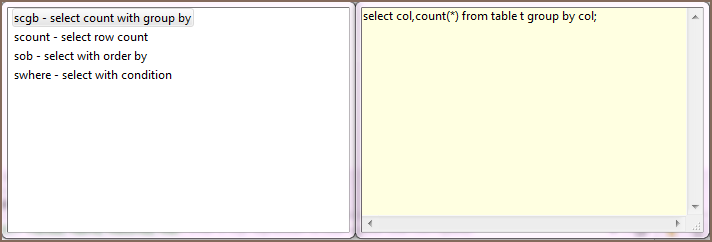SQL Templates
Templates allow you to insert frequently used SQL statements into an SQL script.
To see available templates, press Ctrl+Alt+SPACE or right-click the line in the script pane and click SQL Template on the context menu. A box with a list of available templates appears:

To apply a template, in the SQL Editor, in the script pane:
- Type the template name and press Tab
- Right-click the line where you want to insert a template expression, click SQL Template on the context menu, and then, in the list of templates, double-click the required template name.
The template SQL statement appears in the script.
To edit/add/remove templates, click Configure Icon in the bottom toolbar, then click Preferences -> SQL Editor -> Templates. For more information about managing templates, please visit Eclipse Website.
Standard Eclipse templates:
| Variable | Description |
|---|---|
| ${cursor} | Specifies the cursor position when the template edit mode is left. This is useful when the cursor should jump to a different place than to the end of the template upon leaving the template edit mode. |
| ${year} | Takes the current year value |
| ${date} | Takes the current date value |
| ${time} | Takes the current time value |
| ${dollar} | Takes the dollar sign $. Alternatively, two dollar signs can be used: $$. |
| ${user} | Takes the user name |
| ${word_selection} | Takes the content of the current text selection |
| ${line_selection} | Takes content of all currently selected lines |
DBeaver-specific templates:
| Variable | Description |
|---|---|
| ${schema} | Takes the current schema name |
| ${catalog} | Takes the catalog name |
| ${table} | Takes the current table name (from the active catalog/schema) |
| ${column} | Takes the column name (from the current table) |
